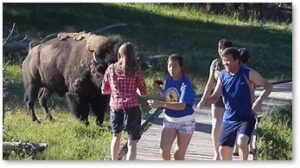One of my husband’s favorite phrases is, “You can’t fix stupid.” That is very true but it is also very unfortunate because stupid seems to be going around a lot lately.
Stupid is Dangerous
 While not as deadly as Covid-19, stupid can be dangerous. It never ceases to amaze me that people:
While not as deadly as Covid-19, stupid can be dangerous. It never ceases to amaze me that people:
- Know so little about the world around them.
- Are incurious and almost reluctant to learn more than they need to get through the day.
- Don’t think beyond the most obvious reality—and sometimes not even that far.
- Can’t imagine bad things happening to them, even when something bad is the logical consequence of their actions.
- Expect to be rescued from the consequences of their own bad decisions and are outraged when they don’t get bailed out.
Every once in a while, examples of one or more of these points pop up in the news. The latest ones come to us from Iceland, where volcanoes are erupting and molten lava is flowing down hillsides.
Carefully Curated Thrills
These eruptions attract visitors, some of them local and some of them tourists. The locals accept that vulcanism is dangerous but still want to watch it. Usually, they know to keep their distance and respect the natural forces. Still, the big eruptions sometimes lure them closer than is wise—or safe.
All this comes as news to tourists, of course, who have a tendency to believe that the world is a big theme park complete with safety inspections and carefully crafted thrills. They hit the ground expecting that someone else has taken care of all that. They expect lights to be strung, guard rails put up, paths to be clearly defined, and park rangers to take responsibility.
The World is Not Disney World
 Thus, they approach an erupting volcano—one of Planet Earth’s most dangerous and unpredictable phenomena—as if it were a ride at Disney World.
Thus, they approach an erupting volcano—one of Planet Earth’s most dangerous and unpredictable phenomena—as if it were a ride at Disney World.
“Terrifying Footage of Lava Flow Released to Scare Off Crater Hunters” by Peter Barker in Newsweek details how people have been approaching solidified lava as if it’s ordinary dirt that certainly presents no danger to them.
Here’s the thing, though: walking on freshly cooled lava can kill you. That crust may look strong enough to hold your weight but it’s not because hot lava is still flowing underneath. If that crust breaks under your feet, well, you drop straight into liquid rock that is 1,300 to 2,000 degrees Fahrenheit (704 to 1093 degreesCelsius). Lava from Iceland’s Fagradalsfjall volcano is flowing at 2.192 degrees Fahrenheit.
Plus, if you fall in, no one will come to rescue you. That’s because a rescue team would have to put themselves in danger of falling through the crust. Also, because you’re stupid.
Dangerous Animal Photo Ops
 Every year, tourists approach wild animals in our National Parks as if they are domesticated livestock waiting placidly to serve as background for their selfie.
Every year, tourists approach wild animals in our National Parks as if they are domesticated livestock waiting placidly to serve as background for their selfie.
A park ranger at Lake Louise in Banff once described to me how she had stopped a man from trying to put his toddler son on an elk so he could take a great picture. Putting yourself in danger is one thing; putting your children in danger is a crime—and as stupid as it gets.
Every year, park rangers at Yellowstone National Park try to keep complacent tourists from posing with bison, getting too close to bison, and turning their backs on the enormous animals. When the tourists ignore the warnings, they get gored, trampled, and tossed into the air by the angry animals. Bison can run at 30 miles an hour so, if you are only ten feet away when it charges, you have no time to react. They also have no problem charging cars that get too close.
That’s Not Yogi Bear
Worse, tourists approach wild bears as if they are friendly, huggable Yogi Bear. At least elk and bison are herbivores. Bears are omnivores and they do like fresh meat. Just ask Timothy Treadwell. Oh, wait, you can’t. The bears ate him.
Some people on safari in African don’t seem to understand that lions are apex predators, best observed and photographed from a distance. Because they paid a lot of money for the experience, they seem to think that it will be safe as going to the zoo. In Africa, however, no bars or moats protect tourists from their own stupid assumptions.
No Warning Signs
Unfortunately, animals and volcanoes don’t present the only dangers to tourists. Even vacation spots promoted as “paradise” can kill you. The brochures and websites don’t put up big warning signs for obvious reasons, but that leaves visitors with a rosy idea of how safe they are.
Take Hawaii, for example. Unlike both coasts of the United States with their sloping continental shelves, the Hawaiian Islands are really mountain tops that rise from the ocean floor. Mauna Kea is a mountain that stands 13,796 feet above sea level. Below the ocean, however it extends another 19,700 feet, which puts its total height at 33,500 feet. Half of that height is submerged, however. Mauna Kea is nearly a mile taller than Everest, which has its summit at 29,035 feet.
That means you will be swimming snorkeling, or surfing in the middle of the Pacific Ocean and the bottom is a long way down. It demands a certain respect. Most visitors never give it a thought, however.
Why do people–Americans in particular—behave this way? I think there are two reasons:
An Expectation of Safety
 We think our everyday lives are safe within the borders of activities we recognize as dangerous, like automobile accidents. We can go to the supermarket without fear of tigers lurking in the parking lot. No T-Rex will show up at the outdoor concert. A volcano will not erupt in the middle of a shopping mall.
We think our everyday lives are safe within the borders of activities we recognize as dangerous, like automobile accidents. We can go to the supermarket without fear of tigers lurking in the parking lot. No T-Rex will show up at the outdoor concert. A volcano will not erupt in the middle of a shopping mall.
In other words, we don’t normally fear for our lives, nor do we think in terms of protecting ourselves from mortal danger. (The Covid-19 pandemic excepted.) By extension, we think that other places we visit will be equally safe.
Oblivious to the Unexpected
We don’t learn to think about situational awareness. Once upon a time, most American men were drafted and served a branch of the armed forces. They were trained to think about danger and how to protect themselves from a hazardous situation. They were taught to expect the unexpected and how to react if it happened. Today, the majority of men and women receive no such training. They go through their lives placidly anticipating more of what they have already experienced. Thus, they don’t take the simplest of precautions or even pay attention to warning signs.
Hold My Beer
None of that has to do with stupid, however. It’s one thing to be thrown into the middle of a disaster that happens without warning. It’s quite another to throw common sense out the window (if you ever had it to begin with) and say, “Hold my beer.” The Darwin Awards are full of people (mostly of the male persuasion) who did just that and removed themselves from the gene pool in the process.
 I remember talking with some co-workers on a business trip. Over drinks they were discussing what, to me, was the engineering equivalent of how many angels can dance on the head of a pin. I asked them to imagine that they were standing outside their hotel room door. They smiled eagerly, thinking I was about to start a new puzzle. I continued, “Now look around and tell me which direction the fire exit is in.”
I remember talking with some co-workers on a business trip. Over drinks they were discussing what, to me, was the engineering equivalent of how many angels can dance on the head of a pin. I asked them to imagine that they were standing outside their hotel room door. They smiled eagerly, thinking I was about to start a new puzzle. I continued, “Now look around and tell me which direction the fire exit is in.”
Foreheads wrinkled and lips frowned. “Why?” they asked. “That’s not important. There won’t be a fire.” See what I mean? They had an expectation of normality. There wouldn’t be a fire because there had never been a fire. In my career, however, I actually had a hotel fire alarm go off three times. I always—always—located the nearest fire stairs so I could find it in an emergency. And I counted the number of doors between my room and the fire stairs so I could get there even in a smoky hall, when one’s eyes shut automatically.
Don’t Be That Stupid Guy
Don’t be the guy who steps on partially cooled lava, who doesn’t read warning signs, who does stupid things because he thinks the world should be a safe place. Think ahead, plan ahead, and pay attention to the world around you. There might just be a T-Rex out there somewhere and being stupid won’t help you.
